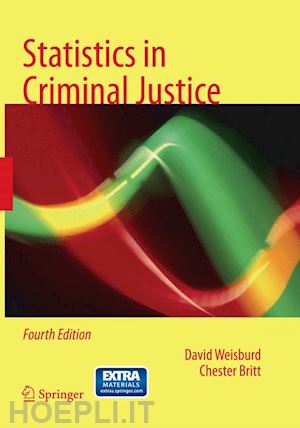
Questo prodotto usufruisce delle SPEDIZIONI GRATIS
selezionando l'opzione Corriere Veloce in fase di ordine.
Pagabile anche con Carta della cultura giovani e del merito, 18App Bonus Cultura e Carta del Docente
Statistics in Criminal Justice takes an approach that emphasizes the application and interpretation of statistics in research in crime and justice. This text is meant for both students and researchers who want to gain a basic understanding of common statistical methods used in this field. In general, the text relies on a building-block approach, meaning that each chapter helps to prepare the student for the chapters that follow. It also means that the level of sophistication of the text increases as the text progresses. Throughout the text there is an emphasis on comprehension and interpretation, rather than computation. However, as the statistical methods discussed become more complex and demanding to compute, there is increasing use and integration of statistical software. This approach is meant to provide the reader with an accessible, yet sophisticated understanding of statistics that can be used to examine real-life criminal justice problems with popular statistical software programs. The primary goal of the text is to give students and researchers a basic understanding of statistical concepts and methods that will leave them with the confidence and the tools for tackling more complex problems on their own.
New to the 4th Edition
· New chapter on experimental design and the analysis of experimental data.
· New chapter on multi-level models, including growth-curve models.
· New computer exercises throughout the text to illustrate the use of both SPSS and Stata.
· Revision of exercises at the end of each chapter that places greater emphasis on using statistical software.
· Additional resources on the text’s web site for instructors and students, including answers to selected problems, syntax for replicating text examples in SPSS and Stata, and other materials that can be used to supplement the use of the text.
Introduction: Statistics as a Research Tool.- Measurement: The Basic Building Block of Research.- Representing and Displaying Data.- Describing the Typical Case: Measures of Central Tendency.- How Typical is the Typical Case?: Measuring Dispersion.- The Logic of Statistical Inference: Making Statements about Populations from Sample Statistics.- Defining the Observed Significance Level of a Test: A Simple Example Using the Binomial Distribution.- Steps in a Statistical Test: Using the Binomial Distribution to make Decisions about Hypotheses.- Chi-Square: A Test Commonly Used for Nominal-Level Measures.- The Normal Distribution and its Application to Tests of Statistical Significance.- Comparing Means and Proportions in Two Samples.- Comparing Means Among More Than Two Samples.- Measuring the Association for Nominal and Ordinal Variables.- Measuring Association for Interval-Level Data.- An Introduction to Bivariate Regression.- Multivariate Regression.- Multivariate Regression: Additional Topics.- Logistic Regression.- Multivariate Regression with Multiple Category Nominal or Ordinal Measures.- Growth Curve Modeling.- Hierarchical Design.- Special Topics: Confidence Intervals.- Special Topics: Statistical Power.- Special Topics: Experimental Design.- Appendices.- Glossary.- Index.











Il sito utilizza cookie ed altri strumenti di tracciamento che raccolgono informazioni dal dispositivo dell’utente. Oltre ai cookie tecnici ed analitici aggregati, strettamente necessari per il funzionamento di questo sito web, previo consenso dell’utente possono essere installati cookie di profilazione e marketing e cookie dei social media. Cliccando su “Accetto tutti i cookie” saranno attivate tutte le categorie di cookie. Per accettare solo deterninate categorie di cookie, cliccare invece su “Impostazioni cookie”. Chiudendo il banner o continuando a navigare saranno installati solo cookie tecnici. Per maggiori dettagli, consultare la Cookie Policy.